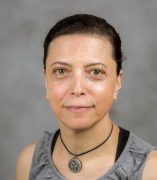
Ursula Perez-Salas, PhD
Visiting Research Assistant Professor
Physics
Contact
Building & Room:
2278 SES
Address:
845 West Taylor St.
Office Phone:
Email:
About
Cells are defined by a membrane, a 4 nm thick film of lipids. Though permeable to small polar molecules, like water, and to small hydrophobic molecules like CO2 and O2, this membrane is impermeable to charged ions and other small molecules. Transport of these molecules are due to proteins that moves them across this barrier. An example is the transport of sodium and potassium in cells, of most significance in neuron signaling. Membranes also define the organelles in Eukaryotic cells and viewing them hosts or scaffold for membrane proteins is simplistic. In the last decade, it was appreciated that lipids mixtures in thermodynamic equilibrium can organize into distinct coexisting lipid phases. This gave rise to the idea that indeed the cell membranes were being organized into lipid phases as well and therefore assisting or adding functionality to the cell. Direct comparison between cell membranes and thermodynamic lipid systems has not been straight forward. The underlying factors that may drive the thermodynamic systems to behave as those found in cells is still under investigation and of active focus in Professor Perez-Salas and her group. Their work consists in detecting nanometer scale phase behavior of thermodynamically equilibrated lipid mixtures using neutron scattering.
Another aspect of membrane biophysics her research group is deeply interested in is the movement of lipids. Lipids can move between different membranes as well as within the same membrane. An example of the movement of lipids between different membranes is the movement of lipids, through water. Since a membrane is composed of a bilayer of lipids, the movement of lipids in the same membrane is when the lipids move between these two layers, and it is called flip-flop or flipping. Recent work by Professor Perez-Salas suggests that cholesterol, an important physiological lipid for animal cells, moves slower than previously thought. This was knowledge was achieved through the use of neutron scattering which allowed the measurements to take place without altering cholesterol chemically in any way. Now the group is pursuing important questions relating to the movement of cholesterol in distinct lipid environments as well as distinct membrane geometries.
As mentioned above, the primary technique used by Professor Perez-Salas' research group is neutron scattering, particularly small angle scattering though neutron reflectivity and spin echo resolved techniques are also being explored. We travel every year to Grenoble France to the Institut Laue-Langevin for at least 3 weeks to perform neutron scattering experiments every summer. We have also traveled to England to the ISIS facility and to Los Alamos in New Mexico for Spin echo resolved measurements. We continue to go to NIST Center for Neutron Research, outside of Washington DC. and in the near future we will be visiting Oak Ridge TN and its High Flux Isotope Reactor. In house, calorimetry is used to determine phase transition properties in lipid mixtures and also microscopy to study structural organization of lipid mixtures in large vesicles, monolayers at the air-water interface using langmuir troughs, as well as supported layers on glass/crystals substrates.
A great collaboration with Distiguished Professor Mark Rasenick's lab and Professor's Perez-Salas Lab recently emerged to study the effect of antidepressants on lipid membranes presenting distinct lipid environments. The hypothesis is that the efficacy of these drugs is in part due to their absorption to membranes as they change the lipid environments in which signaling proteins are found. The Rasenick's lab is extending this hypothesis further and is working on showing that in fact the main affect of these drugs is not through its intended drug target, but rather through its accumulation in membranes.
Selected Publications
- Tarasevich, B., Perez-Salas, U., Masica, D., Philo, J., Kienzle, P., Krueger, S., Majkrzak, C., Gray, J., Shaw, W. Neutron Reflectometry Studies of the Adsorbed Structure of the Amelogenin, LRAP. Journal of Physical Chemistry Part B: Biophysical Chemistry, Biomaterials, Liquids, and Soft Matter Section: B: Biophysical Chemistry and Biomolecules Volume 117 (11) March 2013 3098-3109
- Garg, S., Porcar L., Woodka A.C, Butler P.D., Perez-Salas U. Response to “How Slow Is the Transbilayer Diffusion (Flip-Flop) of Cholesterol?” Biophysical Journal Volume 102 February 2012 947-949
- Garg, S., Porcar L., Woodka A.C, Butler P.D., Perez-Salas U. Noninvasive Neutron Scattering Measurements Reveal Slower Cholesterol Transport in Model Lipid Membranes. Biophysical Journal Volume 101 July 2011 370-377.
- SANS from Proteins, Nucleic Acids, Viruses, Micelles and Vesicles. Chapter in book: Neutron Scattering and Biology. Springer Biological Physics Series, Springer Press, Spring-Verlag, NY. Editors J Fitter, T Gutberlet and J Katsaras., S Krueger, S Gregurick, J Katsaras, M-P Nieh and UA Perez-Salas. (2006).
- G Caliskan, C Hyeob, U Perez-Salas, RM Briber, SA Woodson, D Thirumalai. Semi-flexible Polymer Distance Distribution Function Reveals a Reduction in Persistence Length in the Compaction of a Bacterial Group I ribozyme by cation condensation. Phys. Rev. Lett. 95, 268303 (2005)
Education
BS, Physics (1994), Universidad Autonoma Metropolitana - Iztapalapa
PhD, Physics (2000), University of Maryland - College Park